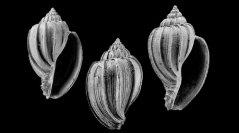

 Geodiversitas
26 (1) - Pages 61-87
Geodiversitas
26 (1) - Pages 61-87This paper includes an addition to the knowledge of Eocithara Fischer, 1883 and a phylogenetic analysis of the related genera. Four Eocithara (s.s.) species are newly recorded in the lower Eocene of the Atlantic Ocean (E. (s.s.) mutica(Lamarck, 1803), E. (s.s.) helenae n. sp., E. (s.s.) sp. 1 and E. (s.s.) sp. 2). Three new species are described: E. (s.s.) rosenkrantzi n. sp. (Thanetian, Greenland), E. (s.s.) helenae n. sp. (Ypresian, France) and E. (s.s.) eucosmia n. sp. (Bartonian, France). For the first time, multispiral protoconchs of Eocithara (s.s.) are reported (E. (s.s.) helenae n. sp.,E. (s.s.) jacksonensis (Harris, 1896) (Priabonian, USA) and E. (s.s.) submutica (d'Orbigny, 1852) (Rupelian, France)). This discovery invalidates the distinction between Harpa Röding, 1798 and Eocithara based on the protoconch (Rehder 1973). Then, a closer inspection of 31 teleoconch characters is provided and tested in a cladistic analysis including Morum Röding, 1798 (one Recent and one fossil species), Eocithara (s.s.) (five fossil species), E. (Refluharpa) Iredale, 1931 (one fossil species), E. (Marwickara) Laws, 1935 (one fossil species), Harpa (four Recent and one fossil species) and Austroharpa Finlay, 1931 (four Recent and one fossil species). The matrix has been processed by the software PAUP 4 and generates three equally parcimonious trees. The consensus tree suggests that all Eocithara are more closely related to Harpa than to Austroharpa. A considerable biogeographic congruence is noted (the Austral clades being clearly distinguished from the Thetyan clades) and the stratigraphical congruence is evaluated by the MSM (Manhattan Stratigraphic Measure) at specific and generic levels.
Mollusca, Gastropoda, Harpidae, Eocithara, Paleogene, homology, phylogeny, new species.